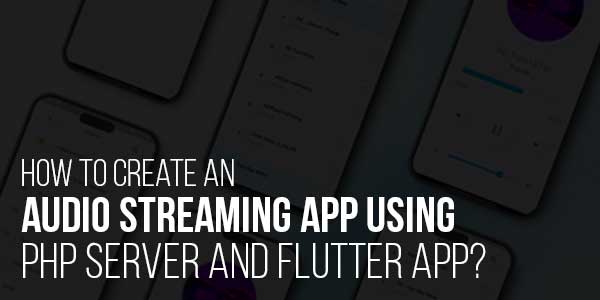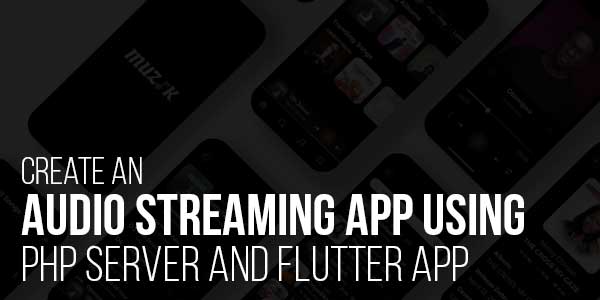
Table of Contents
How To Create An Audio Streaming App Using PHP Server And Flutter App
In today’s digital age, audio streaming applications have become increasingly popular. Whether you want to create the next Spotify competitor or a niche platform for specific content, combining PHP for the backend with Flutter for the frontend provides a powerful solution. This comprehensive guide will walk you through the entire process of building your own audio streaming application.
“The global music streaming market size was valued at $29.45 billion in 2021 and is expected to expand at a compound annual growth rate (CAGR) of 14.7% from 2022 to 2030.” – Grand View Research
Understanding The Audio Streaming App Architecture
Before diving into development, it’s crucial to understand the fundamental architecture of an audio streaming application. Our setup will consist of three main components:
- PHP Backend Server: Handles audio file storage, user authentication, and API endpoints
- MySQL Database: Stores user information, playlists, and audio metadata
- Flutter Mobile App: Provides the user interface and interacts with the backend
Why Choose PHP And Flutter?
PHP remains one of the most reliable server-side technologies with excellent file handling capabilities, while Flutter offers cross-platform development with native performance. This combination provides:
- Cost-effective development
- Rapid prototyping
- Scalable architecture
- Cross-platform compatibility
Setting Up The PHP Backend Server
The backend server will handle all the heavy lifting for our audio streaming application. Let’s configure it properly.
Server Requirements And Installation
Ensure your server meets these minimum requirements:
- PHP 7.4 or higher
- MySQL 5.7+ or MariaDB
- Apache or Nginx web server
- FFmpeg for audio processing (optional)
Install the necessary components on your server. For Ubuntu/Debian systems, you can use:
sudo apt update sudo apt install apache2 mysql-server php libapache2-mod-php php-mysql
Database Structure Design
Create a well-organized database structure to support your audio streaming features. Here are the essential tables:
- users: Stores user credentials and preferences
- audio_files: Contains metadata about audio tracks
- playlists: Manages user-created playlists
- playlist_tracks: Junction table for playlist-track relationships
You can find more about database design best practices in our detailed guide.
Implementing Core PHP Functionality
Now let’s implement the crucial PHP components that will power our audio streaming service.
Audio File Upload And Storage
Create a secure file upload system that handles audio files:
<?php
// audio_upload.php
if ($_SERVER['REQUEST_METHOD'] === 'POST') {
$targetDir = "uploads/audio/";
$fileName = basename($_FILES["audioFile"]["name"]);
$targetFile = $targetDir . uniqid() . "_" . $fileName;
$fileType = strtolower(pathinfo($targetFile, PATHINFO_EXTENSION));
// Validate audio file
$allowedTypes = ['mp3', 'ogg', 'wav'];
if (in_array($fileType, $allowedTypes)) {
if (move_uploaded_file($_FILES["audioFile"]["tmp_name"], $targetFile)) {
// Save to database
$db->query("INSERT INTO audio_files (path, title, duration) VALUES (?, ?, ?)",
[$targetFile, $_POST['title'], $_POST['duration']]);
echo json_encode(['status' => 'success']);
}
}
}
?>Creating The Streaming API
The streaming API needs to handle partial content requests for smooth playback:
<?php
// stream_audio.php
$fileId = $_GET['id'];
$fileData = $db->query("SELECT path FROM audio_files WHERE id = ?", [$fileId])->fetch();
$filePath = $fileData['path'];
$fileSize = filesize($filePath);
$file = fopen($filePath, "rb");
// Handle range requests for streaming
if (isset($_SERVER['HTTP_RANGE'])) {
// Implement partial content logic here
} else {
// Send full file
header("Content-Length: " . $fileSize);
header("Content-Type: audio/mpeg");
fpassthru($file);
}
fclose($file);
?>
Building The Flutter Application
With our backend ready, let’s create the Flutter mobile application that will consume our PHP API.
Setting Up The Flutter Project
Create a new Flutter project and add these essential dependencies to your pubspec.yaml:
dependencies:
flutter:
sdk: flutter
http: ^0.13.4
just_audio: ^0.9.24
audio_session: ^0.1.6
provider: ^6.0.2These packages will handle:
- HTTP requests to our PHP API
- Audio playback functionality
- State management
Creating The Audio Player Service
Implement a robust audio player service in Flutter:
import 'package:just_audio/just_audio.dart';
class AudioPlayerService {
final AudioPlayer _audioPlayer = AudioPlayer();
Future<void> playAudio(String streamUrl) async {
try {
await _audioPlayer.setUrl(streamUrl);
await _audioPlayer.play();
} catch (e) {
print("Error playing audio: $e");
}
}
Future<void> pauseAudio() async {
await _audioPlayer.pause();
}
Future<void> stopAudio() async {
await _audioPlayer.stop();
}
Stream<Duration> getPositionStream() {
return _audioPlayer.positionStream;
}
}Integrating PHP Backend With Flutter Frontend
The magic happens when we connect our Flutter app to the PHP backend through API calls.
Fetching Audio List From Server
Create a service to fetch available audio tracks from your PHP server:
import 'dart:convert';
import 'package:http/http.dart' as http;
class AudioService {
static const String _baseUrl = "https://your-php-server.com/api";
Future<List<Map<String, dynamic>>> fetchAudioList() async {
final response = await http.get(Uri.parse("$_baseUrl/audio_list.php"));
if (response.statusCode == 200) {
return List<Map<String, dynamic>>.from(json.decode(response.body));
} else {
throw Exception('Failed to load audio list');
}
}
}Implementing Streaming Playback
Combine the audio player service with the API data for seamless streaming:
class AudioPlayerScreen extends StatefulWidget {
@override
_AudioPlayerScreenState createState() => _AudioPlayerScreenState();
}
class _AudioPlayerScreenState extends State<AudioPlayerScreen> {
final AudioPlayerService _playerService = AudioPlayerService();
final AudioService _audioService = AudioService();
List<Map<String, dynamic>> _audioList = [];
@override
void initState() {
super.initState();
_loadAudioList();
}
Future<void> _loadAudioList() async {
try {
final list = await _audioService.fetchAudioList();
setState(() => _audioList = list);
} catch (e) {
// Handle error
}
}
@override
Widget build(BuildContext context) {
return Scaffold(
body: ListView.builder(
itemCount: _audioList.length,
itemBuilder: (context, index) {
final audio = _audioList[index];
return ListTile(
title: Text(audio['title']),
onTap: () => _playerService.playAudio(audio['stream_url']),
);
},
),
);
}
}Advanced Features To Enhance Your App
To make your audio streaming app stand out, consider implementing these advanced features.
User Authentication System
Secure your app with a proper authentication system. Our guide on secure user authentication in PHP covers this in detail.
Offline Listening Capability
Implement caching for offline playback using Flutter’s local storage options:
- Store recently played tracks locally
- Allow users to download favorites
- Manage storage permissions properly
Audio Quality Selection
Offer different quality options based on network conditions:
// In your PHP backend
function getStreamUrl($audioId, $quality = 'high') {
$qualityMap = [
'low' => '128kbps',
'medium' => '192kbps',
'high' => '320kbps'
];
return "stream.php?id=$audioId&quality=" . $qualityMap[$quality];
}Optimizing Performance And User Experience
A smooth streaming experience is crucial for user retention. Implement these optimizations:
Server-Side Caching
Reduce server load with proper caching strategies:
- Implement Redis for frequent queries
- Use PHP’s OPcache
- Enable proper HTTP caching headers
Progressive Audio Loading
Load audio metadata first, then stream the content:
// In your Flutter app
Future<void> loadAndPlay(int audioId) async {
final metadata = await _audioService.getMetadata(audioId);
_updateUI(metadata); // Show info immediately
await _playerService.playAudio(metadata['stream_url']);
}Deployment And Scaling Considerations
As your user base grows, you’ll need to consider these deployment strategies.
Choosing The Right Hosting
For audio streaming, consider:
- Dedicated servers for small to medium apps
- Cloud solutions like AWS or Google Cloud for scalability
- CDN integration for global distribution
Monitoring And Analytics
Track usage patterns and performance:
- Implement PHP logging for API requests
- Use Firebase Analytics in Flutter
- Monitor server resource usage
Conclusion
Building an audio streaming app with PHP and Flutter provides a powerful, cost-effective solution that can scale with your user base. By following this guide, you’ve learned how to:
- Set up a robust PHP backend for audio streaming
- Design an efficient database structure
- Create a responsive Flutter frontend
- Implement essential streaming features
- Optimize for performance and user experience
For more advanced topics, check out our guide on advanced Flutter techniques to further enhance your application.
Remember that successful audio streaming apps require continuous improvement. Monitor user feedback, analyze usage patterns, and regularly update both your backend and frontend to stay competitive in this dynamic market.

















Be the first to write a comment.